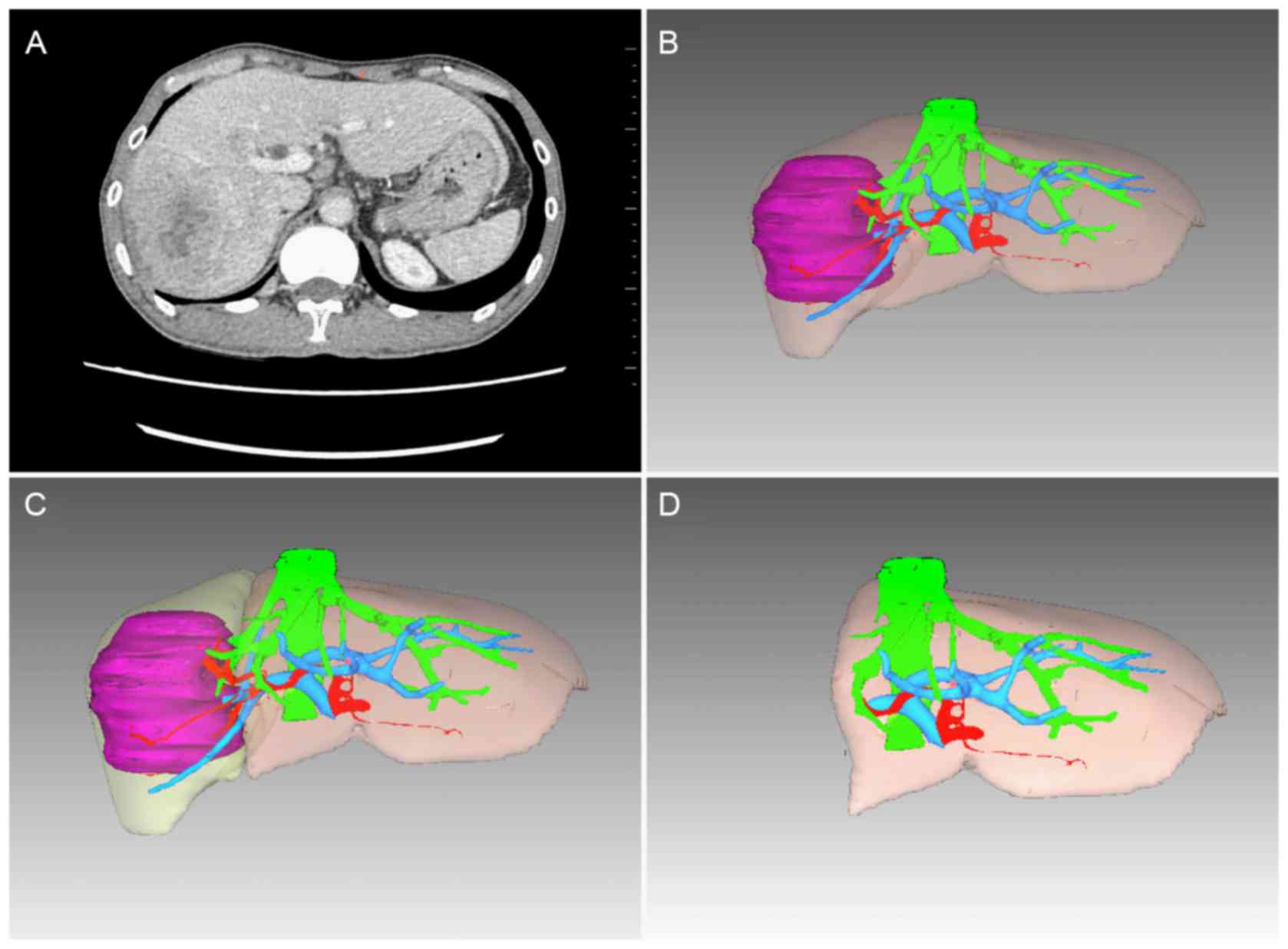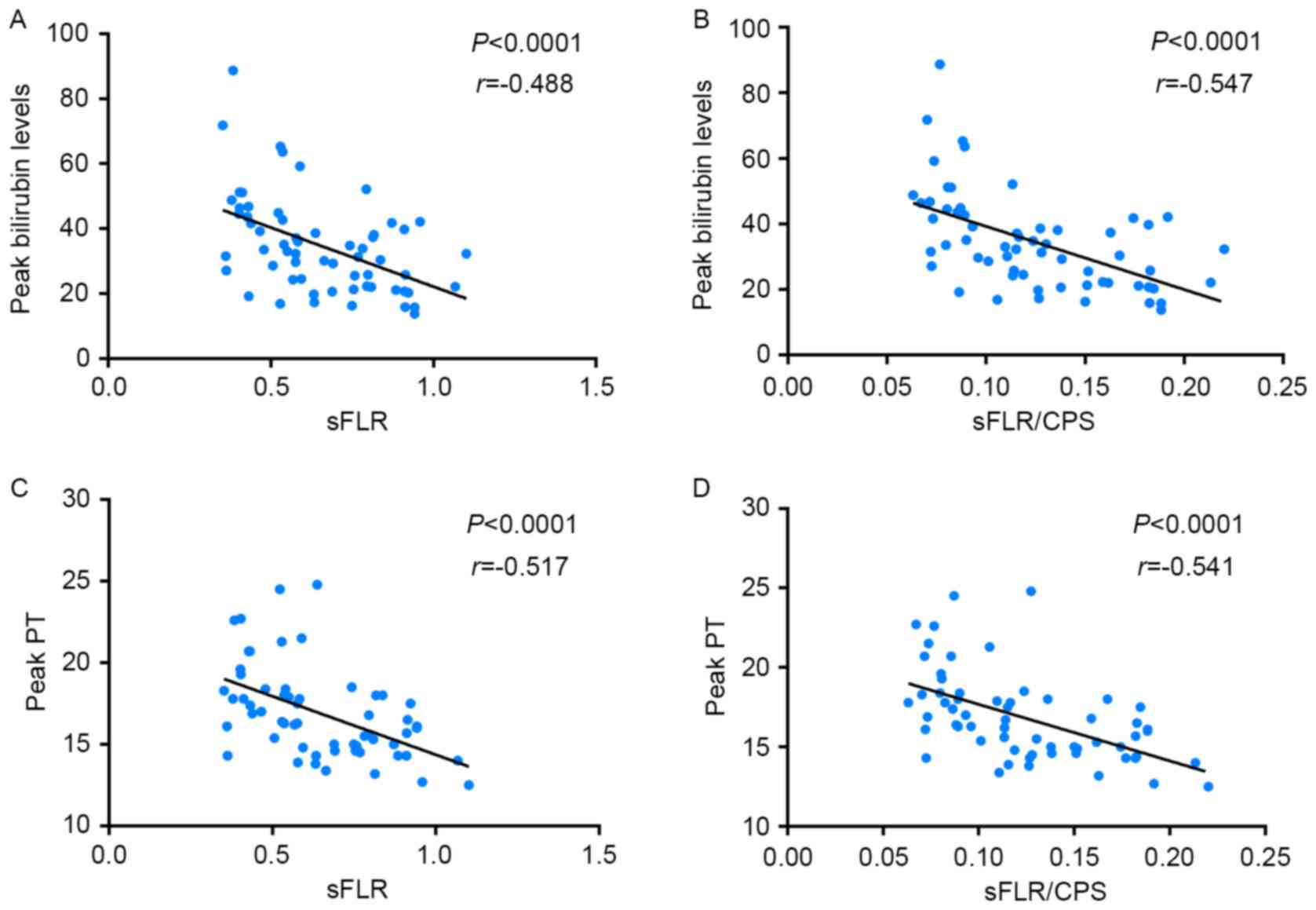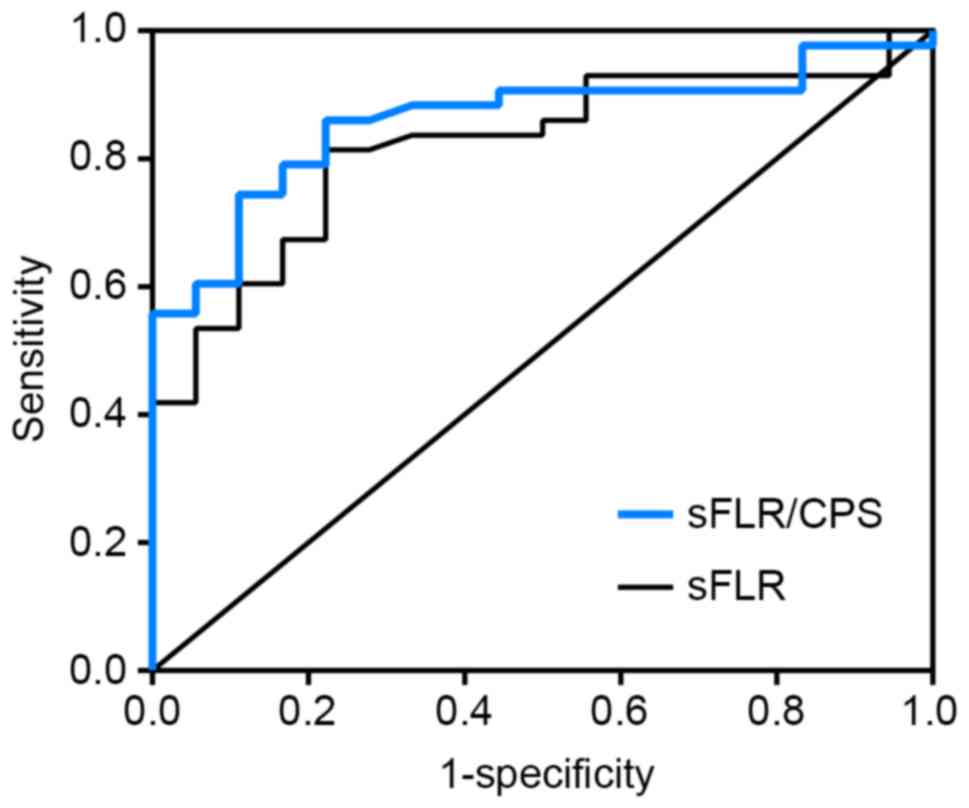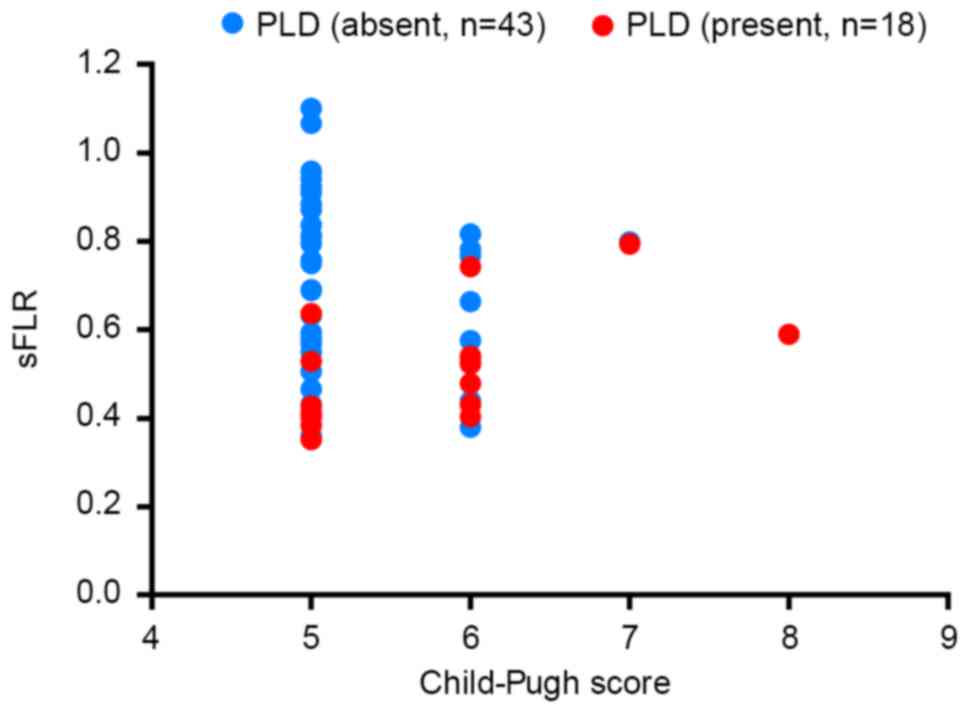Integration of Child‑Pugh score with future liver remnant yields improved prediction of liver dysfunction risk for HBV‑related hepatocellular carcinoma following hepatic resection
- Authors:
- Published online on: March 27, 2017 https://doi.org/10.3892/ol.2017.5919
- Pages: 3631-3637
-
Copyright: © Zou et al. This is an open access article distributed under the terms of Creative Commons Attribution License.
Abstract
Introduction
Liver cancer, primarily hepatocellular carcinoma (HCC), is the third most common cause of mortality from cancer worldwide. Diagnostic and treatment strategies for liver cancer have improved, with hepatic resection being the preferred first-line treatment (1,2). Patients' safety is paramount when performing hepatic surgery, although postoperative mortality occasionally occurs. Therefore, accurate assessment of hepatic functional reserve is important, particularly for hepatitis B virus (HBV)-related HCC patients, since they often possess impaired livers.
Hepatic functional reserve is determined by the quality and quantity of liver cells. The Child-Pugh score (CPS) is widely used to assess the quality of the liver, and hepatic surgeons frequently use it to select HCC patients for resection. The CPS is calculated by five parameters: Presence or absence of encephalopathy, degree of ascites, total serum bilirubin, albumin concentration and prothrombin time. According to the total point score, CPS can be divided into grade A (5–6 points), B (7–9 points) or C (10–15 points) (3). In clinical practice, the majority of HCC patients who are eligible for resection are Child-Pugh classification A patients (2,4). However, postoperative liver dysfunction (PLD) and postoperative mortality occasionally occur in Child-Pugh A patients. It appears that the Child-Pugh classification alone may be unreliable for predicting postoperative outcomes.
To overcome the possible limitations of Child-Pugh classification for predicting postoperative outcomes, liver computed tomography (CT) volumetry has been used to assist in the assessment of hepatic functional reserve in recent years, particularly when selecting HCC patients for major hepatic resection (5). Future liver remnant (FLR) volume measured preoperatively by three-dimensional CT reconstruction can accurately reflect the size of the remnant liver (6,7). Patients with a smaller FLR are at a higher risk of developing PLD or postoperative liver failure (8–10). The main limitation of CT volumetry is the fact that volumetric assessment of the remnant liver does not take into account the quality of the liver parenchyma, and therefore is not reliable in predicting PLD in patients with impaired livers. The safe limit of FLR ranges from 35 to 50% in patients with chronic liver diseases (2,9,11). To improve the prediction of postoperative outcomes, CT volumetry should be complemented with a method that assesses hepatic function.
In the present study, the CPS was used to assess the quality of the remnant liver, and the standardized FLR (sFLR) measurement was used to evaluate the size of the remnant liver. In addition, risk factors were investigated in relation to PLD in patients with HBV-related HCC. The CPS was combined with the sFLR measurement in an attempt to predict PLD more accurately.
Patients and methods
Patients
Between March 2014 and February 2015, 70 patients with HCC underwent three-dimensional CT reconstruction for the preoperative measurement of remnant liver volume prior to hepatectomy at the Department of Hepatobiliary Surgery, Xiangya Hospital, Central South University (Changsha, Hunan, China). Of these 70 patients, 1 patient who had undergone hepatectomy for HCC within 1 year of the present study and 8 patients who were negative for hepatitis B surface antigen were excluded. Ultimately, 61 patients with chronic hepatitis B were included. None of these patients had biliary obstruction prior to surgery or evidence of hepatitis C virus (HCV)-specific antibodies or alcoholic cirrhosis. All surgery was performed through open hepatectomy by a single team of surgeons. Informed consent for the clinical study was obtained from all patients, and the present study was approved by the Institutional Review Board of Central South University. Postoperative liver dysfunction was defined as a prothrombin time of >18 sec (normal range, 10–14 sec) or a peak serum bilirubin level of >51.3 µmol/l (normal range, 5.1–17.1 µmol/l) (12,13) for 7 days after surgery.
Liver volumetry and calculation of the FLR
Prior to surgery, all patients underwent a contrast-enhanced CT angiography scan with a slice thickness of 0.8 mm. Automated volumetry was performed for three-dimensional reconstruction of the liver using medical image analysis software (Myrian®; Intrasense S.A.S., Montpellier, France) and the results were modified by manual contour tracing of the hepatic contour following automated reconstruction. The gall bladder, hepatic inferior vena cava and main branches of the intrahepatic vascular structures were excluded from the reconstructional volume calculation, but the biliary structures were included. Preoperative virtual hepatic resection was performed according to the size and location of the tumors, which were evaluated by two experienced hepatic surgeons. The liver reconstruction and virtual hepatic resection are shown in Fig. 1.
The total liver volume and FLR volume were calculated using image analysis software. The percentage of FLR was calculated as the sFLR using the following equation: sFLR=FLR/standardized liver volume (SLV). The SLV was calculated using the following equation: SLV (cm3)=706.2 × body surface area (BSA; m2)+2.4 (14). The BSA was calculated using an equation that includes bodyweight and height: BSA (m2)=0.00607 × height (cm)+0.0127 × weight (kg)-0.0698 for men; and BSA (m2)=0.00586 × height (cm)+0.0126 × weight (kg)-0.0461 for women. The sFLR/CPS was calculated as a combinatorial measure of sFLR and CPS.
Statistical analysis
Continuous variables are expressed as medians (range) and were compared using the Mann-Whitney U test. Discrete variables were compared using the χ2 test or Fisher's exact test. Univariate analysis and multivariate logistic regression analysis were performed to identify risk factors associated with PLD. Correlation analyses were performed using Pearson's correlation coefficient. The cut-off values for the occurrence of PLD were determined by receiver operating characteristic (ROC) curve analysis. Statistical analyses were performed using SPSS 17.0 (SPSS, Chicago, IL, USA). P<0.05 was considered to indicate a statistically significant difference.
Results
Clinicopathological characteristics and modalities of hepatic resection
A total of 61 patients were enrolled in the present study, comprising 52 men and 9 women, with a median age of 51 years (range, 21–70 years). The surgical modalities were as follows: 18 patients underwent hemihepatectomy (right hemihepatectomy in 14 and left hemihepatectomy in 4), 17 patients underwent bisectionectomy (right anterior sectionectomy in 4, right posterior sectionectomy in 6 and left lateral sectionectomy in 7) and 26 patients underwent partial resection. None of the patients were allergic to anesthesia or experienced cardiac arrest during surgery. Postoperative pathological examinations revealed that 42 patients (68.9%) had liver cirrhosis.
Postoperative liver dysfunction and complications
In total, 18 of the 61 patients (29.5%) developed PLD. Only 1 patient (1.6%) succumbed to intra-abdominal bleeding 15 days after surgery. Of the 61 patients, 19 (31.1%) developed one or more complications after surgery and 11 (18.0%) developed postoperative infection, which was the most common complication. The following additional complications were observed: Pleural effusions in 5 patients (8.2%), bile leakage in 3 patients (4.9%), postoperative hemorrhage in 2 patients (3.3%) and temporary atrial fibrillation in 1 patient (1.6%).
Child-Pugh classification and postoperative liver dysfunction
According to the Child-Pugh classification criteria, 58 patients were of Child-Pugh grade A (with a CPS of 5 in 42 patients and a CPS of 6 in 16 patients) and 3 patients were of Child-Pugh grade B (with a CPS of 7 in 2 patients and a CPS of 8 in 1 patient). A total of 16 of the 58 (27.6%) Child-Pugh A patients developed PLD, and 2 of the 3 Child-Pugh B patients developed PLD. Of the 58 Child-Pugh A patients, 8 of the 42 (19.0%) patients with a CPS of 5 developed PLD and 8 of the 16 (50.0%) patients with a CPS of 6 developed PLD. This difference was significant (Fisher's exact test, P=0.026), indicating that the incidence of PLD for patients with a CPS of 6 was higher than that for patients with a CPS of 5.
Prothrombin time and sFLR are independent risk factors for postoperative liver dysfunction
The univariate analysis revealed no differences between the two groups in terms of age, body mass index, surgical duration, albumin, total bilirubin, alanine aminotransferase, aspartate aminotransferase, blood sugar, cholesterol, platelet count, presence of inflow occlusion, presence of blood transfusion, presence of hepatitis B e antigen, presence of HBV-DNA or presence of liver cirrhosis (P>0.05; Table I). However, tumor diameter (P=0.043), blood loss (P=0.015), prothrombin time (PT) (P=0.007), CPS (P=0.007) and sFLR (P<0.001) were significantly different between the two groups (Table I).
A multivariate logistic regression analysis was performed to identify risk factors for PLD. Age, body mass index, operating time, albumin, total bilirubin, alanine aminotransferase, blood sugar, cholesterol, platelet count, inflow occlusion, positive HBeAg, liver cirrhosis, PT, blood loss, tumor diameter and sFLR were entered into the multivariate logistic regression model to avoid collinearity (Table II). A prolonged PT and small sFLR were identified as significant independent predictors of PLD (Table II).
Table II.Multivariate logistic regression analysis for risk factors of postoperative liver dysfunction. |
sFLR and sFLR/CPS correlate with postoperative peak bilirubin levels and postoperative peak prothrombin time
Pearson's correlation analysis revealed that the postoperative peak bilirubin level had a stronger negative correlation with sFLR/CPS (P<0.0001, r=−0.547) than with sFLR (P<0.0001, r=−0.488) (Fig. 2). The postoperative peak PT had a stronger negative correlation with sFLR/CPS (P<0.0001, r=−0.541) than with sFLR (P<0.0001, r=−0.517) (Fig. 2).
sFLR and sFLR/CPS are predictors of postoperative liver dysfunction
ROC curve analysis revealed that the cut-off value of sFLR for predicting PLD was 54.5%, with 81.4% sensitivity and 77.8% specificity (Fig. 3). In total, 14 of the 22 (63.6%) patients with an sFLR <54.5% developed PLD, compared with 4 of the 39 (10.3%) patients with a larger sFLR. This difference was statistically significant (χ2=19.268, P<0.001). The cut-off value of sFLR/CPS for predicting PLD was 0.0916, with 86.0% sensitivity and 77.8% specificity (Fig. 3). Of the 20 patients with an sFLR/CPS of <0.0916, 14 (70.0%) developed PLD compared with 4 of 41 (9.8%) patients with a higher sFLR/CPS, and this difference was statistically significant (χ2=23.455, P<0.001). This result indicates that sFLR/CPS was a more useful predictor of PLD in HBV-related HCC patients following hepatic resection compared with sFLR alone.
sFLR and CPS are linked to postoperative liver dysfunction. The distribution of PLD in patients with different CPSs and different sFLRs is demonstrated in Fig. 4. According to the distribution of PLD, the majority of patients with a CPS of 5 who developed PLD had an sFLR of <43%, and the majority of the patients with a CPS of 6 who developed PLD had an sFLR of <54%.
Discussion
In the present study, the incidence of PLD among Child-Pugh A patients was revealed to be significantly higher in patients with a CPS of 6 than in those patients with a CPS of 5 (P<0.05), indicating that hepatic function may not be the same for all HCC patients with Child-Pugh A. For a number of years, the selection of HCC patients for hepatic resection has been based on the Child-Pugh classification (15); however, flaws in this classification system have been described recently (16–18). First, a number of the variables included in the Child-Pugh classification are interrelated (e.g., ascites and serum albumin levels). Second, the grading of ascites and encephalopathy is subjective. Third, the cut-off value for each variable is selected empirically. Finally, the Child-Pugh classification system does not offer a wide degree of discrimination for HCC patients undergoing hepatic resection, the majority of whom have Child-Pugh A disease. Certain studies have reported the unreliability of the Child-Pugh classification system for predicting postoperative outcomes (17,19–21). The data from the present study revealed that heterogeneity may exist in Child-Pugh A patients. There is a requirement to identify ‘good risk’ and ‘poor risk’ Child-Pugh A patients. Furthermore, even for multiple patients with a given CPS, different postoperative outcomes were observed in the present study, possibly since the remnant liver volume varied for these patients.
More recently, with the advancement of three-dimensional imaging technologies, the importance of preoperative volumetric analysis for major hepatic resection has been increasingly emphasized (5,22). Previous studies have demonstrated that a small FLR is associated with worse postoperative hepatic function (23,24). As in previous studies, the findings from the present study suggested that sFLR is an independent risk factor for PLD. However, there were patients in the present study who had a small FLR but did not develop PLD, indicating that FLR may not be the only factor that affects postoperative outcomes. There is little doubt that hepatic function also plays an important role in predicting postoperative outcomes (25,26). Theoretically, with a higher CPS, a larger FLR is required to avoid PLD. Judging from the distribution of PLD (Fig. 4), data from the present study revealed that to avoid PLD in HBV-related HCC patients following hepatic resection, an sFLR of 43% is relatively safe when the CPS is 5, and an sFLR of 54% is relatively safe when the CPS is 6. It is predicted that a higher sFLR is required when the CPS is 7 or 8. These results require testing and verifying with more cases in clinical practice, in particular with more patients with a CPS of 7 or 8.
In addition, by using sFLR/CPS as a combinatorial measure of sFLR and CPS, it was revealed that sFLR/CPS showed a stronger negative correlation with postoperative peak bilirubin levels and postoperative peak PT than sFLR, and ROC curve analysis revealed that the cut-off value of sFLR/CPS could predict PLD more accurately than sFLR. This indicates that sFLR/CPS is a more accurate predictor of postoperative hepatic function than sFLR.
The present study has a number of limitations. First, the time span of the study was short, and all the subjects were enrolled from a single study center. In addition, the study focused on HCC patients infected with HBV. It is possible that the results do not apply to HCC patients in other countries where HCV infection or alcoholic cirrhosis may be the most common cause of HCC. Therefore, these study results require validation in Western and Asia-Pacific patient populations. Finally, no evaluation was performed of the correlations between the preoperative liver volumetry and the weight of the resected specimen.
In conclusion, the combination of sFLR and CPS was identified as aiding a more accurate assessment of hepatic functional reserve and improving prevention of the occurrence of postoperative liver dysfunction compared with either CPS or sFLR alone.
Acknowledgements
The authors would like to thank Dr Saidan Zhang (Institute of Medical Science, Xiangya Hospital, Central South University, Changsha, China) for providing assistance with the statistical analysis. The present study was supported by the National Nature Science Foundation of China (grant nos. 81372630 and 81372631).
References
|
Cauchy F, Soubrane O and Belghiti J: Liver resection for HCC: Patient's selection and controversial scenarios. Best Pract Res Clin Gastroenterol. 28:881–896. 2014. View Article : Google Scholar : PubMed/NCBI | |
|
Fonseca AL and Cha CH: Hepatocellular carcinoma: A comprehensive overview of surgical therapy. J Surg Oncol. 110:712–719. 2014. View Article : Google Scholar : PubMed/NCBI | |
|
Pugh RN, Murray-Lyon IM, Dawson JL, Pietroni MC and Williams R: Transection of the oesophagus for bleeding oesophageal varices. Br J Surg. 60:646–649. 1973. View Article : Google Scholar : PubMed/NCBI | |
|
Garcea G, Ong SL and Maddern GJ: Predicting liver failure following major hepatectomy. Dig Liver Dis. 41:798–806. 2009. View Article : Google Scholar : PubMed/NCBI | |
|
Lim MC, Tan CH, Cai J, Zheng J and Kow AW: CT volumetry of the liver: Where does it stand in clinical practice? Clin Radiol. 69:887–895. 2014. View Article : Google Scholar : PubMed/NCBI | |
|
Wigmore SJ, Redhead DN, Yan XJ, Casey J, Madhavan K, Dejong CH, Currie EJ and Garden OJ: Virtual hepatic resection using three-dimensional reconstruction of helical computed tomography angioportograms. Ann Surg. 233:221–226. 2001. View Article : Google Scholar : PubMed/NCBI | |
|
Simpson AL, Geller DA, Hemming AW, Jarnagin WR, Clements LW, D'Angelica MI, Dumpuri P, Gonen M, Zendejas I, Miga MI and Stefansic JD: Liver planning software accurately predicts postoperative liver volume and measures early regeneration. J Am Coll Surg. 219:199–207. 2014. View Article : Google Scholar : PubMed/NCBI | |
|
Schindl MJ, Redhead DN, Fearon KC, Garden OJ and Wigmore SJ: The value of residual liver volume as a predictor of hepatic dysfunction and infection after major liver resection. Gut. 54:289–296. 2005. View Article : Google Scholar : PubMed/NCBI | |
|
Clavien PA, Petrowsky H, DeOliveira ML and Graf R: Strategies for safer liver surgery and partial liver transplantation. N Engl J Med. 356:1545–1559. 2007. View Article : Google Scholar : PubMed/NCBI | |
|
Ribero D, Amisamo M, Bertuzzo F, Langella S, Lo Tesoriere R, Ferrero A, Regge D and Capussotti L: Measured versus estimated total liver volume to preoperatively assess the adequacy of the future liver remnant: Which method should we use? Ann Surg. 258:801–807. 2013. View Article : Google Scholar : PubMed/NCBI | |
|
Wagener G: Assessment of hepatic function, operative candidacy, and medical management after liver resection in the patient with underlying liver disease. Semin Liver Dis. 33:204–212. 2013.(In Danish, English). View Article : Google Scholar : PubMed/NCBI | |
|
Ribero D, Abdalla EK, Madoff DC, Donadon M, Loyer EM and Vauthey JN: Portal vein embolization before major hepatectomy and its effects on regeneration, resectability and outcome. Br J Surg. 94:1386–1394. 2007. View Article : Google Scholar : PubMed/NCBI | |
|
Facciuto M, Contreras-Saldivar A, Singh MK, Rocca JP, Taouli B, Oyfe I, LaPointe Rudow D, Gondolesi GE, Schiano TD, Kim-Schluger L, et al: Right hepatectomy for living donation: Role of remnant liver volume in predicting hepatic dysfunction and complications. Surgery. 153:619–626. 2013. View Article : Google Scholar : PubMed/NCBI | |
|
Urata K, Kawasaki S, Matsunami H, Hashikura Y, Ikegami T, Ishizone S, Momose Y, Komiyama A and Makuuchi M: Calculation of child and adult standard liver volume for liver transplantation. Hepatology. 21:1317–1321. 1995. View Article : Google Scholar : PubMed/NCBI | |
|
Pugh RN, Murray-Lyon IM, Dawson JL, Pietroni MC and Williams R: Transection of the oesophagus for bleeding oesophageal varices. Br J Surg. 60:646–649. 1973. View Article : Google Scholar : PubMed/NCBI | |
|
Durand F and Valla D: Assessment of prognosis of cirrhosis. Semin Liver Dis. 28:110–122. 2008. View Article : Google Scholar : PubMed/NCBI | |
|
Johnson PJ, Berhane S, Kagebayashi C, Satomura S, Teng M, Reeves HL, O'Beirne J, Fox R, Skowronska A, Palmer D, et al: Assessment of liver function in patients with hepatocellular carcinoma: A new evidence-based approach-the ALBI grade. J Clin Oncol. 33:550–558. 2015. View Article : Google Scholar : PubMed/NCBI | |
|
Kaplan DE, Dai F, Aytaman A, Baytarian M, Fox R, Hunt K, Knott A, Pedrosa M, Pocha C, Mehta R, et al: Development and performance of an algorithm to estimate the Child-Turcotte-Pugh Score from a national electronic healthcare database. Clin Gastroenterol Hepatol. 13:2333–2341, e1-e6. 2015. View Article : Google Scholar : PubMed/NCBI | |
|
Schneider PD: Preoperative assessment of liver function. Surg Clin North Am. 84:355–373. 2004. View Article : Google Scholar : PubMed/NCBI | |
|
Hoekstra LT, de Graaf W, Nibourg GA, Heger M, Bennink RJ, Stieger B and van Gulik TM: Physiological and biochemical basis of clinical liver function tests: A review. Ann Surg. 257:27–36. 2013. View Article : Google Scholar : PubMed/NCBI | |
|
Forner A, Llovet JM and Bruix J: Hepatocellular carcinoma. Lancet. 379:1245–1255. 2012. View Article : Google Scholar : PubMed/NCBI | |
|
Cieslak KP, Runge JH, Heger M, Stoker J, Bennink RJ and van Gulik TM: New perspectives in the assessment of future remnant liver. Dig Surg. 31:255–268. 2014. View Article : Google Scholar : PubMed/NCBI | |
|
Hirashita T, Ohta M, Iwashita Y, Iwaki K, Uchida H, Yada K, Matsumoto T and Kitano S: Risk factors of liver failure after right-sided hepatectomy. Am J Surg. 206:374–379. 2013. View Article : Google Scholar : PubMed/NCBI | |
|
Truant S, Boleslawski E, Sergent G, Leteurtre E, Duhamel A, Hebbar M and Pruvot FR: Liver function following extended hepatectomy can be accurately predicted using remnant liver volume to body weight ratio. World J Surg. 39:1193–1201. 2015. View Article : Google Scholar : PubMed/NCBI | |
|
Stockmann M, Lock JF, Riecke B, Heyne K, Martus P, Fricke M, Lehmann S, Niehues SM, Schwabe M, Lemke AJ and Neuhaus P: Prediction of postoperative outcome after hepatectomy with a new beside test for maximal liver function capacity. Ann Surg. 250:119–125. 2009. View Article : Google Scholar : PubMed/NCBI | |
|
Okabe H, Beppu T, Chikamoto A, Hayashi H, Yoshida M, Masuda T, Imai K, Mima K, Nakagawa S, Kuroki H, et al: Remnant liver volume-based predictors of postoperative liver dysfunction after hepatectomy: Analysis of 625 consecutive patients from a single institution. Int J Clin Oncol. 19:614–621. 2014. View Article : Google Scholar : PubMed/NCBI |













